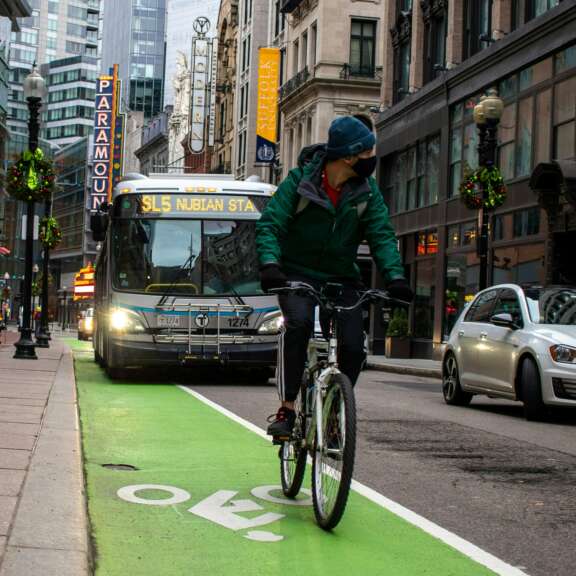Names, Not Numbers
A human-centered approach to tackling homelessness in Rockford

Some nights, you’ll find members of the City of Rockford’s homelessness outreach program on the streets at 4am. There, they travel from tents to cars to encampments to check in with locals experiencing homelessness. It’s part of a program called Built for Zero – a movement of more than 80 cities and counties worldwide working to solve homelessness, one population at a time.
When the program started, Rockford had about 700 people experiencing homelessness. Today, thanks to the Build for Zero framework and coordinated outreach across local services, Rockford has housed more than 550 people in need. The City has also substantially decreased the time it takes to get folks into housing.
Rockford is the first U.S. city to make such significant strides in decreasing homelessness. But this story is about so much more than just the numbers. It's about a city getting to know it’s community members to better serve them. It’s about seeing people as unique individuals, and building programs with that in mind. It’s about bringing the entire community together to provide a basic need in a human-focused way.
Unifying the user experience
Rockford’s efforts to end homelessness started with a project they call ‘coordinated entry’ in 2015. The idea was to simplify the user experience for people experiencing homelessness – with a single touchpoint for city services all coordinated around the goal of permanent housing.
Before coordinated entry, people experiencing homelessness in Rockford would have to travel to different shelters and offices across town to get the services they needed. If they needed medical service, they’d need to go to one office. For a bed for the night, they might need to walk to several different shelters to find availability. It was a disjointed experience and often meant more people ended up on the streets, because they couldn’t find a shelter bed nearby.
“We wanted to cut red tape and make it easier for people to actually obtain the services they needed to get into housing”
– Angie Walker, Homelessness Program Coordinator, City of Rockford
Now, anyone experiencing homelessness in Rockford can come into an office, call in, or find outreach workers on the street to get information for all the different services they need.
Angie’s outreach team can tell people, with certainty, which shelters have beds each night. If they know a certain barrier, like seeing a doctor or filing for public benefits, is blocking someone from getting permanent housing, they do what they can to help get them on track with that next step.
Names, not numbers
Coordinated entry works because city agencies and other organizations that work with the homeless population started talking to each other and sharing resources.
Working together, they use a shared Google doc to keep track of all the information about each person experiencing homelessness in the city at any given time. The doc includes their first and last name, last known location, and details about their situation. This ‘by-name list’ is a cornerstone of the Build for Zero program.
“The by-name list helps us to keep people at the center of everything we do. We're not just looking at some random number and not just talking about ‘the homeless people’. We’re talking about Jose, we’re talking about Jeff, we’re talking about Randy – we’re talking about individual people.”
– Angie Walker, Homeless Program Coordinator, City of Rockford
The list breaks apart Rockford’s homeless population into five groups: veterans, chronically homeless, youth under 25, families with children, and single adults. This breakdown helps them serve the community better because they can get all the right people in the room to coordinate outreach and services for each particular group. Folks in the room for a meeting on veteran homelesness will be different from folks in the room for a meeting on youth homelessness because different organizations naturally serve these groups.
This method helps the team’s regular case conferencing meetings stay more focused and strategic. With representatives across each of the different organizations and agencies that serve that particular population, Angie’s team is able to get the complete picture and plan a more strategic outreach and housing plan for individuals.
Building relationships to understand individual challenges
To create the by-name list, Angie’s team focuses primarily on on-the-ground outreach – oftentimes working late evenings or during the middle of the night to meet the people in the places they’re most comfortable. They have conversations at people’s cars, tents, and encampments, which helps build trust and shows they’re serious about wanting to help.
“Our team goes out every other week for nighttime outreach between 7pm and 7am,” she explains. “We switch it up and go at different times so we don’t miss anyone.”
This is where they start making relationships with people to learn about their barriers to housing. They spend time getting to know each person and check in on how they’re doing – the end goal is always to get them in permanent housing, but it isn’t always a direct process. Sometimes folks aren’t ready for housing right away. In those cases, it’s Angie’s team’s job to listen and, with time, help them get there by understanding what’s stopping them in the first place.
“You have to know people individually and on a personal level to actually be successful. Otherwise I don't think you'll get very far.”
– Angie Walker, Homeless Program Coordinator, City of Rockford
Some of the most common barriers to housing Angie and her team see are eviction history, inability to provide landlord references, having a criminal background, illness, and the cost of housing.
“We’ve found it's really important to focus on the system’s barriers – what’s actually preventing them from getting housing? If John is mentally ill – that’s something we might know about him, but it’s not necessarily the actual thing preventing him from getting a place to live. Plenty of mentally ill people around the country have housing, plenty of alcoholics have housing, plenty of drug addicts have housing. We want to know what specifically is causing this one person not to be able to get into housing.”
Once they identify a barrier, they work together to solve it. If landlord references are someone's barrier to entry, Angie’s team might sit down with the landlord and explain the situation, perhaps using friends and family as references instead.
Bottoms-up and top-down leadership
By bringing together a cross-org team of folks to coordinate efforts for each homeless population, the City of Rockford is able to provide a unified solution that thinks about a person’s end-to-end experience, instead of just solving for one piece of it.
At first though, Angie says getting everyone involved wasn’t so easy. When some organizations wouldn’t show up for case conferencing, key information that could impact an individual's ability to get housing would be missed. To solve for this, Angie and her team used their alliance with the mayor – who’d been a close supporter of the work with Build for Zero since day one. Having the mayor as a vocal champion of their work helped get more organizations involved, show up for case regular meetings, and unite around the project.
There have also been some unlikely partnerships that Angie credits with contributing to the success of the program.
“We have a great relationship with our fire department and the paramedics because they know everybody on the streets. They're a really good tool,” says Angie. “We also work really closely with our local Park District Police. They know everybody who sleeps outside, because oftentimes, they're in the parks. [...] They chat with people and relay a lot of information to us as well.”
Lasting learnings
Rockfords efforts to house their homeless community inspired us from the moment we first read about them. We believe that much of what went into their program’s success can be adapted by others in public service to drive meaningful impact too.
Put humans first: Angie’s team in Rockford uses the by-name list to keep the individuals they serve at the forefront of their work. This helps humanize the problem and helps them think about solutions for actual people, not just policies or numbers or generalizations like “the homeless”.
Focus on the root cause – not just the symptoms: Through their outreach, Angie and her team get to personally know the names and faces behind Rockford’s homeless population. They work hard to understand individual needs in order to solve system-level problems. Yes, it’s more work than building a more standard one-size-fits-all approach. But it’s also incredibly more effective. By focusing on solving the root cause of someone's homelessness, Angie’s team is able to create real, lasting solutions that positively impact their community, rather than just throwing more resources at short-term solutions like adding more beds to shelters.
Build relationships (and partnerships) with the local community: Building relationships and trust within the homeless community helped Angie and her team get to the heart of the challenges they were facing and help solve for them. Partnering with different organizations helps them develop a clear picture of the problem they’re trying to solve and avoid silos. They were able to bring folks together to drive an even greater impact because different groups rallied around a common mission.


